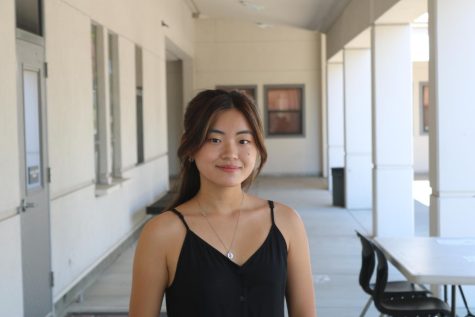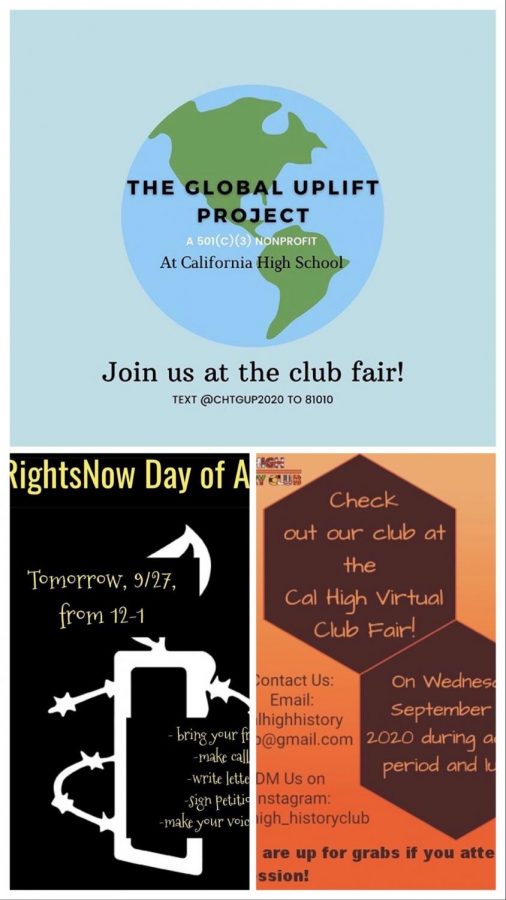Clubs go virtual
Despite schooling online, clubs still trying to connect students while at home
Clubs posted flyers online to attract students during the school’s first virtual Club Faire on Sept. 23.
Club Faire is usually a lunchtime event filled with yelling, bright posters, and clubs rallying potential members.
This chaotic atmosphere has come to be expected every September when students are trying to promote their clubs and get others to join them. This year, Club Faire was replaced by black rectangles on a screen and often awkward, one-sided conversations.
“The club faire was organized really neatly, but it was difficult to see what each club was offering with just text,” said freshman Ada Wang. “It was also really annoying to scroll through 123 clubs.”
The necessary change to Club Faire – hosted virtually for the first time in Cal High’s history on Sept. 23 during student support and lunch – illustrates the challenges clubs face connecting students and their outside interests this year amidst the coronavirus pandemic.
“Having clubs online makes the interactions harder due to not being face to face with a person,” junior Anuj Patel, a member of the Data Science club, said. “That usually makes it harder to have fun.”
Leadership adviser Ross Dautel planned a master list of every approved club, including the club president, adviser, and meeting times. It was released through a schoolwide email so students could find the clubs that interested them.
Potential club members had the option of attending a Zoom meeting hosted by clubs, watching pre-recorded videos that club officers make beforehand, or viewing virtual flyers about the club.
Once clubs begin meeting, presidents are highly encouraged to host them from home using Zoom or Google Meet.
“At this point, we are discouraging all forms of in person meetings,” Dautel said. “It’s not allowed on campus. The expectation is that all meetings are held virtually.”
Many freshmen view clubs going online as a positive step to maintain some sort of normalcy since clubs help create social interaction for a lot of high school students.
“I think it would be really cool and very different,” said freshman Anoushka Gogoi, who plans on joining the Mission Mindset club. “The only thing that’s kinda sad is that we won’t be able to eat free food.”
Some older students think clubs might even lose potential members because of the meetings being virtual instead of in person this year, but there’s not much the school can do with campus being closed because of COVID-19.
“The club members might not sign up because it’s harder online,” Patel said. “A lot of people keep their cameras off.”
Many students have experienced difficulty communicating in class because of problems with microphones and webcams. These problems will likely persist with club meetings.
Without seeing students’ faces during meetings, it could create a barrier between participating club members. Luckily, club leaders have plans to get past this.
“Although there is a decrease in in-person human interaction, we aim to replicate a very similar environment virtually by planning multiple activities and keeping members constantly engaged,” Future Business Leaders of America co-president Sharanya Sharma said. “It may be tough, but it will be a new and unique experience for all of us.”
Club advisers also have ideas on how to improvise, adapt, and overcome these challenges posed by virtual meetings.
“I plan to make myself available to answer any questions the student leaders have and provide any support that they need. I’ll attend the club meetings and help address any issues as they arise,” Educore Tutoring adviser Janice Saiki said. “Online tutoring is new to us, so we are still working on some of the details and making improvements as we go.”
Club presidents may be worried about member attendance, but advisors are doing their best to help possible members join.
“Teachers can answer questions from students who are interested in joining the club and help publicize the club to the student community,” Saiki said.

Senior Daphne So back again at the Californian for her third year, this time as co-Editor-in-Chief. She has a crippling YesStyle addiction, which is the...





